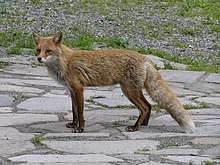Ezo red fox
The ezo red fox (Vulpes vulpes schrencki) is a subspecies of red fox widely distributed in Hokkaido, Sakhalin, the Kuril Islands and the surrounding islands of Japan.
| Ezo red fox | |
|---|---|
 | |
| Scientific classification | |
| Kingdom: | Animalia |
| Phylum: | Chordata |
| Class: | Mammalia |
| Order: | Carnivora |
| Family: | Canidae |
| Genus: | Vulpes |
| Species: | |
| Subspecies: | V. v. schrencki |
| Trinomial name | |
| Vulpes vulpes schrencki Kishida, 1924 | |
The Ezo red fox's formal name, Kitakitsune (北狐), was given to the subspecies by Kyukichi Kishida when he studied them in Sakhalin in 1924.[1][2] In the Ainu languages it is known as cironnup, sumari, kimotpe or hurep.[3]
Description
The ezo red fox is somewhat larger than the Japanese red fox found in Honshu, Shikoku and Kyushu, and the outer part of the ear and the limbs are black. There are many similarities with continental red foxes.
The ezo red fox has 42 teeth: 6 incisors, 2 canine teeth, 8 premolar, 4 upper molar and 6 lower molars. Ezo foxes normally have eight nipples: a pair on the chest; two pairs in the abdomen; and one pair in the groin. Individual cases of seven to ten nipples are known. There are five digits on each forelimb and four on the back-leg, a total of 18.[2]
Ecology
Ezo red foxes range widely from grassland to alpine belts in Hokkaido. They mainly eat rats, mountain hares, birds and insects. They also eat fruit and nuts in autumn. In tourist spots and in some urban areas there are individuals who feed on the street. They have also been observed feeding on the placenta of cattle in pastures or at disposal facilities.
They dig holes or tunnels to make their lairs. The females give birth to kits in the early spring, which are grown and independent by late autumn. Males act independently and do not contribute to the raising of offspring.
Diseases and parasites

Ezo red foxes are especially prone to infestation by echinococcus and helminths. These were introduced to Hokkaido via cultured silver foxes from the Aleutian Islands in the modern era. Echinococcosis is a tapeworm type infection in Ezo red foxes. An infection cycle is maintained between Hokkaido's Ezo red fox and the field mouse. Since 1999 activities have been undertaken to reduce the infection rate by causing anthelmintics to be ingested by wild Ezo red foxes.
Echinococcus worm eggs excreted with the faeces of foxes can be ingested by humans and cause echinococcosis. This can be treated if it is found at an early stage, but there is a possibility of death if treatment is delayed or if the parasitism is at a site where operations are difficult. Ezo red foxes can also infect domestic animals and pets.
Relationships with humans
Ezo red foxes are wild animals and there has long been a supposition against human intervention, including supplementary feeding. It is thought that this will adversely affect not only Ezo red foxes but their habitats. However, echinococcosis infection of humans by Ezo red foxes is considered a problem and there have been calls to act to reduce this, partially on the basis that the condition was introduced by human agency.[4]
The familiarisation of Ezo red foxes with humans by feeding brings changes to its behaviour.[5] For example, it has been confirmed that Ezo red foxes in Shiretoko National Park leave their home territories in April when the tourist season is over, seeking human food in Utoro city. Since the 1980s Ezo red foxes have permanently settled in green spaces in some urban areas, such as Sapporo.
Popularisation
Ezo red foxes were featured in the documentary film Ezo Red Fox Story released in 1978.
Ezo Red Fox (Kitakitsune) is featured as a supporting character in the "Kemono Friends" franchise, voiced by Suzuko Mimori.
References
| Wikimedia Commons has media related to Vulpes vulpes schrencki. |
| Wikispecies has information related to Vulpes vulpes schrencki |
- Kadosaki, Masaaki (20 Oct 2009). Wildlife Survey Trace Study Manual (in Japanese). Hokkaido Publishing Planning Centre. p. 397. ISBN 978-4832809147.
- Kadosaki, Masaaki (20 Oct 2009). Wildlife Survey Trace Study Manual (in Japanese). Hokkaido Publishing Planning Centre. p. 361. ISBN 978-4832809147.
- Chiri, Mashiho. Classification Ainu Dictionary.
- "エキノコックス症の知識と予防". Health and Welfare Department Health and Safety Bureau Regional Health Division (in Japanese). Hokkaido Agency. Retrieved 4 Jul 2017.
- Tsukada, Hideharu (2006). "Feeding of the Ezo Red Foxes and Their Risk of Echinococcosis". Feeding Wildlife Problem: Does Good Intent Cause? Ecosystem Disturbances, Wildlife Harms, Infectious Diseases, Daily Damages (in Japanese). Gaijin Library. pp. 127–141. ISBN 9784805209004.